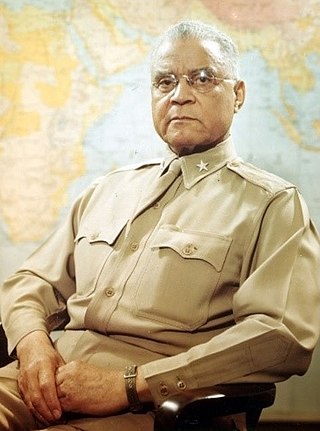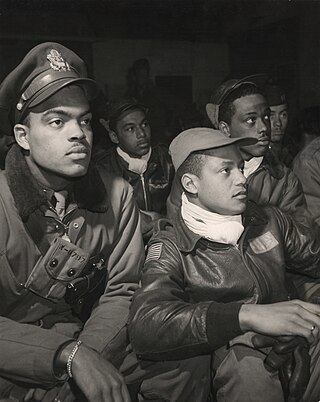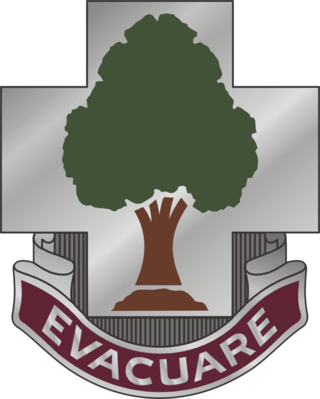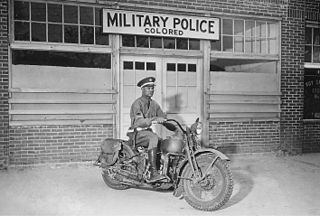
The 25th Station Hospital was an all African American unit of nurses who served in the Army Nurse Corps during World War II. The unit was the first African American group sent overseas and were stationed for a short tour in Liberia in 1943.

The 25th Station Hospital was an all African American unit of nurses who served in the Army Nurse Corps during World War II. The unit was the first African American group sent overseas and were stationed for a short tour in Liberia in 1943.
The 25th Station Hospital was the first United States Army medical unit of African American service members to deploy overseas during World War II. [1] These nurses from the Army Nurse Corps were sent to Liberia in March 1943. [1] [2] There were 30 nurses in the unit and they were there to support United States troops on airfields and rubber plantations. [1] The group's chief nurse was First Lieutenant Susan E. Freeman and they were stationed on Roberts Field. [3] [2] Most of the soldiers they tended suffered from malaria. [4]
The nurses did not carry weapons and to show this, they all wore Red Cross arm bands. [4] They were also issued helmets, gas masks and canteens. [4] The work that the nurses were asked to do was duplicated by Army corpsmen and morale among the nurses' unit suffered. [1] The same year they were deployed, the 25th Station Hospital Unit was recalled because of the morale issue and poor health in the unit. [1]
In April 1944, official from Liberia requested and were granted permission to honor Lieutenant Freeman with the Liberian Human Order of African Redemption. [5] She was also awarded a Mary Mahoney Award from the National Association of Colored Graduate Nurses in 1944 for her work in Liberia. [5]

Benjamin Oliver Davis Sr. was a career officer in the United States Army. One of the few black officers in an era when American society was largely segregated, in 1940 he was promoted to brigadier general, the army's first African American general officer.

The 92nd Infantry Division was an African-American, later mixed, infantry division of the United States Army that served in World War I, World War II, and the Korean War. The military was racially segregated during the World Wars. The division was organized in October 1917, after the U.S. entry into World War I, at Camp Funston, Kansas, with African-American soldiers from all states. In 1918, before leaving for France, the American buffalo was selected as the divisional insignia due to the "Buffalo Soldiers" nickname, given to African-American cavalrymen in the 19th century. The divisional nickname, "Buffalo Soldiers Division", was inherited from the 366th Infantry, one of the first units organized in the division.
The Mediterranean Theater of Operations, United States Army (MTOUSA), originally called the North African Theater of Operations, United States Army (NATOUSA), was a military formation of the United States Army that supervised all U.S. Army forces which fought in North Africa and Italy during World War II.

The United States Navy Nurse Corps was officially established by Congress in 1908; however, unofficially, women had been working as nurses aboard Navy ships and in Navy hospitals for nearly 100 years. The Corps was all-female until 1965.

The Royal Army Dental Corps (RADC) is a specialist corps in the British Army that provides dental health services to British Army personnel and their families in war and in peace. The corps is a part of the British Army's Army Medical Services.

The Army Medical Department of the U.S. Army (AMEDD), formerly known as the Army Medical Service (AMS), encompasses the Army's six medical Special Branches. It was established as the "Army Hospital" in July 1775 to coordinate the medical care required by the Continental Army during the Revolutionary War. The AMEDD is led by the Surgeon General of the U.S. Army, a lieutenant general.

The 24th Infantry Regiment is a unit of the United States Army, active from 1869 until 1951, and since 1995. Before its original dissolution in 1951, it was primarily made up of African-American soldiers.

The military history of African Americans spans from the arrival of the first enslaved Africans during the colonial history of the United States to the present day. African Americans have participated in every war fought by or within the United States, including the Revolutionary War, the War of 1812, the Mexican–American War, the Civil War, the Spanish–American War, World War I, World War II, the Korean War, the Vietnam War, the Gulf War, the War in Afghanistan, and the Iraq War.

The term military medicine has a number of potential connotations. It may mean:

Lieutenant Colonel Charity Adams Earley was an American United States Army officer. She was the first African-American woman to be an officer in the Women's Army Auxiliary Corps and was the commanding officer of the first battalion of African-American women to serve overseas during World War II. Adams was the highest-ranking African-American woman in the army by the completion of the war. The 6888th Central Postal Directory Battalion's motto was "No Mail, Low Morale." A monument honoring this unique group of women was dedicated at Fort Leavenworth, Kansas on November 30, 2018.

The 115th Field Hospital is a field hospital of the United States Army formed in 1917 and perpetuated until today. The hospital has participated in World War I, World War II, Desert Storm, Operation Iraqi Freedom and Operation Enduring Freedom (Afghanistan). As of March 2019, the 115th Combat Support Hospital reorganized and re-designated as a field hospital and is now a component unit of the 32d Hospital Center.

The United States Army Air Forces was the major land-based aerial warfare service component of the United States Army and de facto aerial warfare service branch of the United States during and immediately after World War II (1941–1947). It was created on 20 June 1941 as successor to the previous United States Army Air Corps and is the direct predecessor of the United States Air Force, today one of the six armed forces of the United States. The AAF was a component of the United States Army, which on 2 March 1942 was divided functionally by executive order into three autonomous forces: the Army Ground Forces, the United States Army Services of Supply, and the Army Air Forces. Each of these forces had a commanding general who reported directly to the Army Chief of Staff.

The Adjusted Service Rating Score was the system that the United States Army used at the end of World War II in Europe to determine which soldiers were eligible to be repatriated to the United States for discharge from military service as part of Operation Magic Carpet. This system was referred to as "The Point System" by U.S. soldiers.

The United States Army Nurse Corps (USANC) was formally established by the U.S. Congress in 1901. It is one of the six medical special branches of officers which – along with medical enlisted soldiers – comprise the Army Medical Department (AMEDD). The ANC is the nursing service for the U.S. Army and provides nursing staff in support of the Department of Defense medical plans. The ANC is composed entirely of Registered Nurses (RNs) but also includes Nurse Practitioners.

A series of policies were formerly issued by the U.S. military which entailed the separation of white and non-white American soldiers, prohibitions on the recruitment of people of color and restrictions of ethnic minorities to supporting roles. Since the American Revolutionary War, each branch of the United States Armed Forces implemented differing policies surrounding racial segregation. Racial discrimination in the U.S. military was officially opposed by Harry S. Truman's Executive Order 9981 in 1948. The goal was equality of treatment and opportunity. Jon Taylor says, "The wording of the Executive Order was vague because it neither mentioned segregation or integration." Racial segregation was ended in the mid-1950s.

The Royal Australian Air Force Nursing Service (RAAFNS) was a branch of the Royal Australian Air Force, which existed from 1940 to 1946, and from 1948 to 1977. Members served in World War II, the Korean War, the Malayan Emergency, and the Vietnam War.

The Greensboro Training Center is a closed United States Army Air Forces installation. It was last assigned to the United States Army Personnel Distribution Command. It was closed on 15 December 1946.

Liberia did not become militarily involved in World War II until January 1944, with the election of William Tubman, at which time the country declared war on Germany and Japan. However, even before the start of Liberia's official military involvement, the nation participated in the war for two years under the terms of a Defense Agreement with the United States. Apart from Ceylon and the Belgian Congo, Liberia possessed one of the few remaining sources of rubber for the Allies. To guarantee a steady supply of rubber from the world's largest rubber plantation, operated at Harbel by the Firestone Company since 1926, the US government built roads throughout the country, created an international airport, and transformed the capital, Monrovia, by building a deep water port.

Margaret E. Bailey was a United States Army Nurse Corps colonel. She served in the Corps for 27 years, from July 1944 to July 1971, nine of which she served in France, Germany, and Japan. During her career, Bailey advanced from a second lieutenant to colonel, the highest achievable military rank in the Nurse Corps. She set several landmarks for black nurses in US military, becoming the first black lieutenant colonel in 1964, the first black chief nurse in a mixed, non-segregated unit in 1966, and the first black full colonel in 1967.

Della Hayden Raney was an American nurse in the Army Nurse Corps. Raney was the first African American nurse to report for duty in World War II and the first to be appointed chief nurse. In 1944, she became the first black nurse affiliated with the Army Air Corps promoted to captain, and she was later promoted to major in 1946. Raney retired from the Army in 1978.